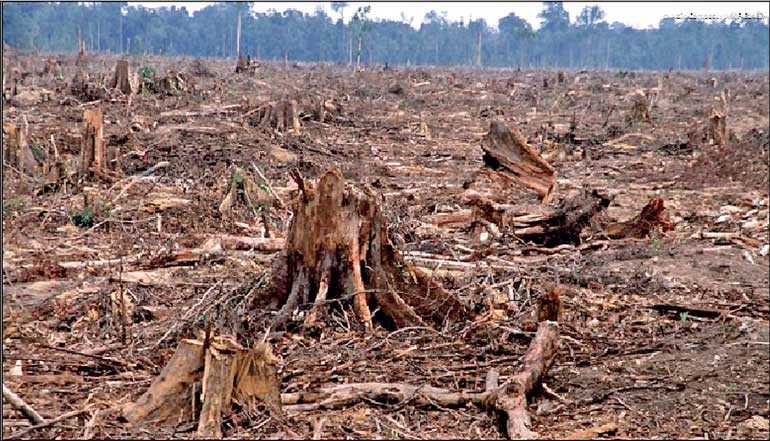Saturday Oct 18, 2025
Saturday Oct 18, 2025
Wednesday, 3 March 2021 00:00 - - {{hitsCtrl.values.hits}}

If deforestation continues the way it happens today, we all will have to face bitter consequences before long
 Day by day, sad incidents of forest destruction are reported and it seems that culprits are not serious about the value of the forests, which are much more than a collection of trees.
Day by day, sad incidents of forest destruction are reported and it seems that culprits are not serious about the value of the forests, which are much more than a collection of trees.
In many parts of the country clearing of forests for agriculture, including the age-old practice of chena cultivation has been a continual process. Apart from that, forests are destroyed for obtaining timber for fuel, construction, manufacturing, mining for gems and other valuable resources, and wildlife hunting after setting fire.
Another cause of damage is development activities implemented by various authorities that lead to the clearing of forests to a considerable extent. Because of all these acts, our forest cover is fast dwindling and deforestation has become a serious environmental issue.
When the family size of those who engage in chena cultivation as their sole source of revenue expands, and if the successors do not have the opportunity to engage in a different livelihood, they too need lands to cultivate. When the options are limited, successors may have no choice other than encroaching into the adjacent forest areas. This type of forest destruction propagates in parallel with the growing population engaged in rain fed agriculture.
Nevertheless, the second type, which are organised crimes, mostly happen in sensitive forest areas incurring massive damage to the forest often with political patronage or support of corrupted officials, as reported. Therefore, it is not fair to consider the above scenarios equally as they come under different contexts and appeal to different interventions for prevention.
The concern of the citizenry for forests depends on how they perceived the value of them. In Sri Lanka, only environmentalists and some social media users raise the voice against forest destruction, when it happens, and the point of concern is that the rest may be ignorant of the real value of forests. The people are the ultimate managers of forests and that the higher their level of knowledge and awareness, the better the preservation of forests will be.
Education at school is a fundamental factor that determines the level of knowledge and attitudes of citizens. Most of our children learn about the environment from the textbooks and they have no opportunity to experience the nature as they are running a marathon to pass the exams. They identify the entire flora and fauna by way of pictures printed in textbooks.
Unfortunately, they do not have a chance to experience the real beauty and value of a forest, as there are no such activities in the curriculum. Further, our schoolbooks hardly contain any information on the vast benefits of trees to our ecosystem other than relating the basic theory we all came across during our school time that trees absorb carbon dioxide and emit oxygen in the process of photosynthesis.
There is a saying, “To walk in nature is to witness a thousand miracles”. Still, a recent incident proves that there are people in society who do not know at least that we need oxygen to breathe, which is very unfortunate.
We are living in an era where climate change has become a major challenge. Ever-increasing amounts of carbon dioxide emitted to the atmosphere, mainly through fuel burning have caused the globe to warm up rendering myriad bitter consequences.
In the meantime, deforestation has been identified as the second major driver of climate change. It is the forest, which can help us reduce the excessive amount of carbon dioxide in the atmosphere playing a leading role in the fight against global warming. Forest acts as a carbon sink and probably the only entity that is capable of carbon regulation. On average, the amount of oxygen produced annually by an acre of trees is about 2,500 kg while the annual oxygen consumption of a person is 750 kg.
Trees relieve people from stress, make them relaxed and comfortable, and improve positive well-being. Without trees, the world would not have been this much beautiful and appealing. The earth may have millions of different varieties of trees. Many trees do not remain the same throughout the year.
When we plant a tree we are emotionally attached to it and keen to observe its growth day by day. Sometimes we plant a tree to mark a special event of our life and it may be our birthday, the day of marriage, or the demise of a close relative.
It is interesting to note that Bhutan has introduced the Gross National Happiness (GNH) index, which is used to measure the happiness and well-being of its people. One of the pillars out of four pillars that constitute GNH is environmental conservation.
Even our tourism industry, which is one of the main sectors that bring us foreign exchange, vastly depends on the natural beauty of this country. If we fail to maintain that unique natural beauty, the country will no longer be a place of attraction to foreign tourists while jeopardising the industry.
The contribution of trees to the ecosystem is massive. Trees improve air quality by trapping solid particles, retard rainfall-runoff and thereby mitigate floods, increase groundwater recharge, and preserve soil by preventing erosion. Not only forests but even green areas such as shrubs and turfs inside forests also contribute to the ecosystem immensely. Although they get less attention, they can filter air by removing dust and absorb many pollutants like carbon monoxide, sulphur dioxide, and nitrogen dioxide.
Forests are habitats for wildlife and many of them live either on trees or under the shelter of trees. All most all wildlife depend on the foods provided by the forest. Therefore, without forests, no wildlife will exist on the earth. The same is true for humans and we must preserve forests in order to assure the existence of humankind.
According to World Food and Agriculture Organization (FAO), by 2015, the estimated forest area in the world equalled 31% of the earth’s surface area. Nearly half that forest existed in tropical areas such as Africa, South America, and Indonesia. In contrast, we have only 17% of forest cover left by now according to the experts, despite the fact that Sri Lanka is also a tropical country with higher annual rainfall.
Vertical development is the concept followed by many other countries today. High-rise buildings including housing apartments are constructed to save land space. Modern technology is used in agriculture together with high water use efficiencies to increase productivity rather than expanding agricultural land area irresponsibly, which leads to the clearing of forests further. Human settlements in less developed rural areas are discouraged and those areas are used for afforestation.
Sri Lanka too has to implement these strategies sooner than later as policy interventions on all fronts to protect our existing forests, which is a challenge that lies ahead. If deforestation continues the way it happens today, we all will have to face bitter consequences before long.
(Eng. Thushara Dissanayake is a Chartered Engineer specialised in water resources engineering with over 20 years of experience)